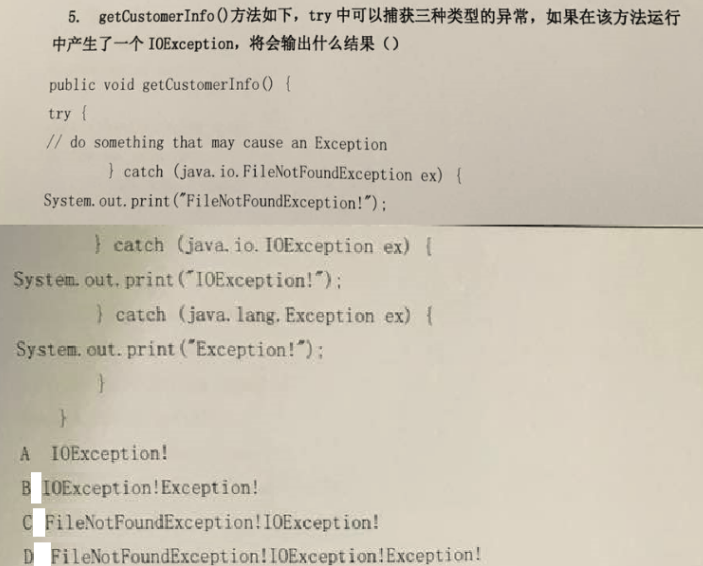day12_课后练习
代码阅读题
第1题
public static void main(String[] args) {
int test = test(3,5);
System.out.println(test);//8
}
public static int test(int x, int y){
int result = x;
try{
if(x<0 || y<0){
return 0;
}
result = x + y;
return result;//(1)先把result的值8放到操作数栈中,(2)然后走finally(3)结束当前方法
}finally{
result = x - y;//这个result=-2的值,不会放到操作数栈中,因为没有return
}
}
/*
* (1)finally块中的代码是无论try中是否发生异常,也无论catch是否可以捕获异常,
* 也不管try和catch中是否有return语句,都会执行的部分
* (2)如果finally中有return语句,那么try...catch...finally结构
* 一定从finally中的return回去
* (3)如果finally中没有return语句,那么try...catch...finally结构
* 才会从try或catch中的return回去,但是finally值中代码不会影响最终的返回值
*/
第2题
public class Test02 {
public static void main(String[] args) {
try{
return;
}finally{
System.out.println("finally");
}
}
}
/*
* finally块中的代码是无论try中是否发生异常,也无论catch是否可以捕获异常,
* 也不管try和catch中是否有return语句,都会执行的部分
*/
第3题
public class Test03 {
{
System.out.println("a");
}
static{
System.out.println("b");
}
Test03(){
System.out.println("c");
}
public static String getOut(){
try{
return "1";
}catch(Exception e){
return "2";
}finally{
return "3";
}
}
public static void main(String[] args) {
System.out.println(getOut());
}
}
/*
* (1)main()执行之前,需要先完成所在类的初始化
* (2)类初始化由两部分代码组成:①静态变量的显式赋值代码②静态代码块
* (3)没有创建对象,不会执行实例初始化相关的代码
* (4)finally块中的代码是无论try中是否发生异常,也无论catch是否可以捕获异常,
* 也不管try和catch中是否有return语句,都会执行的部分
* (5)如果finally中有return语句,那么try...catch...finally结构
* 一定从finally中的return回去
*/
第4题
public class Test04 {
static int i = 0;
public static void main(String[] args) {
System.out.println(test());
}
public static int test(){
try{
return ++i;//(1)先自增(2)把i的值放到操作数栈(3)走finally
}finally{
return ++i;//(4)再自增(5)又取i的值放到操作数栈(4)结束方法
}
}
}
/*
* (1)finally块中的代码是无论try中是否发生异常,也无论catch是否可以捕获异常,
* 也不管try和catch中是否有return语句,都会执行的部分
* (2)如果finally中有return语句,那么try...catch...finally结构
* 一定从finally中的return回去,但是try和catch中的return语句中返回值的表达式会执行。
* (3)如果finally中没有return语句,那么try...catch...finally结构
* 才会从try或catch中的return回去,但是finally值中代码不会影响最终的返回值
*/
第5题
import java.io.IOException;
public class Test05 {
public static void main(String[] args) {
int a = -1;
try{
if(a>0){
throw new RuntimeException("");
}else if(a<0){
throw new IOException("");
}else{
return ;
}
}catch(IOException ioe){
System.out.println("IOException");
}catch(Throwable e){
System.out.println("Throwable");
}finally{
System.out.println("finally");
}
}
}
/*
* (1)throw用于手动抛出异常
* (2)无论是JVM抛出的异常还是throw抛出的异常都需要catch处理
* (3)catch是多分支结构,从上到下按顺序匹配,只会进入第一个匹配上的catch分支
* (4)finally块中的代码是无论try中是否发生异常,也无论catch是否可以捕获异常,
* 也不管try和catch中是否有return语句,都会执行的部分
*/
第6题
public class Test06 {
public static int fun(){
int result = 5;
try{
result = result / 0;
return result;
}catch(Exception e){
System.out.println("Exception");
result = -1;
return result;//(1)先把-1放到操作数栈(2)走finally(3)结束
}finally{
result = 10;
System.out.println("I am in finally.");
}
}
public static void main(String[] args) {
int x = fun();
System.out.println(x);
}
}
/*
* (1)finally块中的代码是无论try中是否发生异常,也无论catch是否可以捕获异常,
* 也不管try和catch中是否有return语句,都会执行的部分
* (2)如果finally中有return语句,那么try...catch...finally结构
* 一定从finally中的return回去
* (3)如果finally中没有return语句,那么try...catch...finally结构
* 才会从try或catch中的return回去,但是finally值中代码不会影响最终的返回值
*/
第7题
public static int aMethod(int i)throws Exception{
try{
return i / 10;
}catch(Exception ex){
throw new Exception("exception in aMethod");
}finally{
System.out.println("finally");
}
}
public static void main(String[] args) {
try {
aMethod(0);
} catch (Exception e) {
System.out.println("exception in main");
}
}
/*
* (1)finally块中的代码是无论try中是否发生异常,也无论catch是否可以捕获异常,
* 也不管try和catch中是否有return语句,都会执行的部分
* (2)throw用于手动抛出异常
* (3)throws用于将异常抛给调用者处理
*/
代码编程题
第8题
案例:
在一款角色扮演游戏中,每一个人都会有名字和生命值,角色的生命值不能为负数。
要求:当一个人物的生命值为负数的时候需要抛出自定的异常
操作步骤描述:
(1)自定义异常类NoLifeValueException继承RuntimeException
①提供空参和有参构造
②在有参构造中,需要调用父类的有参构造,把异常信息传入
(2)定义Person类
①属性:名称(name)和生命值(lifeValue)
②提供空参构造
③提供有参构造:使用setXxx方法给name和lifeValue赋值
④提供setter和getter方法:
在setLifeValue(int lifeValue)方法中,首先判断,如果 lifeValue为负数,就抛出NoLifeValueException,异常信息为:生命值不能为负数:xx;
然后在给成员lifeValue赋值。
(3)定义测试类Test08
①使用满参构造方法创建Person对象,生命值传入一个负数
由于一旦遇到异常,后面的代码的将不在执行,所以需要注释掉上面的代码
②使用空参构造创建Person对象
调用setLifeValue(int lifeValue)方法,传入一个正数,运行程序
调用setLifeValue(int lifeValue)方法,传入一个负数,运行程序
③分别对①和②处理异常和不处理异常进行运行看效果
package com.atguigu.test08;
public class NoLifeValueException extends RuntimeException{
public NoLifeValueException() {
super();
}
public NoLifeValueException(String message) {
super(message);
}
}
package com.atguigu.test08;
public class Person {
private String name;
private int lifeValue;
public Person() {
super();
}
public Person(String name, int lifeValue) {
super();
setName(name);
setLifeValue(lifeValue);
}
public String getName() {
return name;
}
public void setName(String name) {
this.name = name;
}
public int getLifeValue() {
return lifeValue;
}
public void setLifeValue(int lifeValue) {
if(lifeValue<0){
throw new NoLifeValueException("生命值不能为负数:" + lifeValue);
}
this.lifeValue = lifeValue;
}
}
package com.atguigu.test08;
public class Test08 {
public static void main(String[] args) {
try {
Person p = new Person("白蛇",-1);
} catch (Exception e) {
e.printStackTrace();
}
try {
Person p2 = new Person();
p2.setLifeValue(10);
p2.setLifeValue(-10);
} catch (Exception e) {
e.printStackTrace();
}
}
}
第9题
请编写代码演示OOM错误
package com.atguigu.test09;
public class Test09_01 {
public static void main(String[] args) {
int[] arr = new int[Integer.MAX_VALUE];
}
}
package com.atguigu.test09;
import java.util.ArrayList;
/*
设置JVM参数
-verbose:gc
-Xms20M
-Xmx20M
-Xmn10M
-XX:+PrintGCDetails
-XX:SurvivorRatio=8
其中:
Xms:最小堆
Xmx:最大堆
Xmn:新生代的大小
PrintGCDetails:打印GC日志
SurvivorRatio:Eden区和Survivor比例
*/
public class Test09_02 {
public static void main(String[] args) {
ArrayList list=new ArrayList();
//通过不断的创建对象达到OOM
while (true){
list.add(new Object());
}
}
}
选择题
第10题

BC
throws的异常类型要>=方法中抛出的异常类型
【修饰符】 返回值类型 方法名(【形参列表】)throws 异常列表{
}
第11题

catch是多分支结构,从上到下按顺序匹配,只会进入第一个匹配上的catch分支
简答题
问题:
- 请描述异常的继承体系
- 请描述你对错误(Error)的理解
- 请描述你对异常(Expection的理解)
- 请描述你对运行时异常(RuntimeException)的理解
- throw与throws的区别
- 异常处理方式有几种,分别是什么?详细阐述每种方式对异常是如何处理的
























 1097
1097











 被折叠的 条评论
为什么被折叠?
被折叠的 条评论
为什么被折叠?








